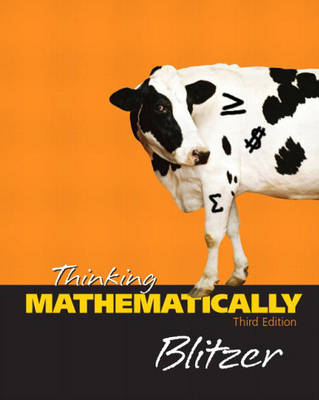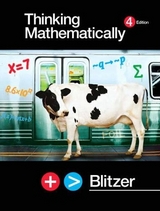
Thinking Mathematically
Pearson (Verlag)
978-0-13-143243-7 (ISBN)
- Titel erscheint in neuer Auflage
- Artikel merken
For a one- or two-term course in Liberal Arts Mathematics, Survey of Mathematics, Finite Mathematics, and Mathematics for education majors.
Known for their well-conceived, relevant applications and meticulously annotated examples, Bob Blitzer's books balance the needs of appropriate coverage and student motivation while helping students develop strong critical thinking skills. This text gives students the skill-building and practice essential at this level, along with the applications and technology needed to foster an appreciation of mathematics through their college careers and beyond. Blitzer's goal is to show students how mathematics can be applied to their lives in interesting, enjoyable, and meaningful ways. His accessible writing style helps students relate to and grasp the material.
(NOTE: Each chapter concludes with Summary, Review, and Test.)
1. Problem Solving and Critical Thinking.
Inductive and Deductive Reasoning. Estimation and Graphs. Problem Solving.
2. Set Theory.
Basic Set Concepts. Venn Diagrams and Subsets. Venn Diagrams and Set Operations. Set Operations and Venn Diagrams with Three Sets. Surveys and Cardinal Numbers.
3. Logic.
Statements, Negations, and Quantified Statements. Compound Statements and Connectives. Truth Tables for Negations, Conjunctions, and Disjunction. Truth Tables for the Conditional and the Biconditional. Equivalent Statements, Variations of Conditional Statements, and De Morgan's Laws. Arguments and Truth Tables. Arguments and Euler Diagrams.
4. Number Representation and Calculation.
Our Hindi-Arabic System and Early Positional Systems. Number Bases in Positional Systems. Computation in Positional Systems. Looking Back at Early Numeration Systems.
5. Number Theory and the Real Number System.
Number Theory: Prime and Composite Numbers. The Integers; Order of Operations. The Rational Numbers. The Irrational Numbers. Real Numbers and Their Properties. Exponents and Scientific Notation. Arithmetic and Geometric Sequences.
6. Algebra: Equations and Inequalities.
Algebraic Expressions and Formulas. Solving Linear Equations. Applications of Linear Equations. Ratio, Proportion, and Variation. Solving Linear Inequalities. Solving Quadratic Equations.
7. Algebra: Graphs, Functions, and Linear Systems.
Graphing and Functions. Linear Functions and Their Graphs. Quadratic Functions and Their Graphs. Exponential Functions. Systems of Linear Equations. Linear Inequalities in Two Variables. Linear Programming.
8. Consumer Mathematics and Financial Management.
Percent. Simple Interest. Installment Buying. The Cost of Home Ownership. Investing in Stocks, Bonds, and Mutual Funds.
9. Measurement.
Measuring Length: The Metric System. Measuring Area and Volume. Measuring Weight and Temperature.
10. Geometry.
Points, Lines, Planes, and Angles. Triangles. Polygons, Quadrilaterals, and Perimeter. Area and Circumference. Volume. Right Triangle Trigonometry. Beyond Euclidian Geometry.
11. Counting Methods and Probability Theory.
The Fundamental Counting Principle. Permutations. Combinations. Fundamentals of Probability. Probability with the Fundamental Counting Principle, Permutations, and Combinations. Events Involving Not and Or; Odds. Events Involving And; Conditional Probability. Expected Value.
12. Statistics.
Sampling, Frequency Distributions, and Graphs. Measures of Central Tendency. Measures of Dispersion. The Normal Distribution. Scatter Plots, Correlation, and Regression Lines.
13. Mathematical Systems.
Mathematical Systems. Rotational Symmetry, Groups, and Clock Arithmetic.
14. Voting and Apportionment.
Voting Methods. Flaws of Voting Methods. Apportionment Methods. Flaws of Apportionment Methods.
15. Graph Theory.
Graphs, Paths, and Circuits. Euler Paths and Euler Circuits. Hamilton Paths and Hamilton Circuits. Trees.
| Erscheint lt. Verlag | 18.3.2004 |
|---|---|
| Sprache | englisch |
| Maße | 275 x 273 mm |
| Gewicht | 1996 g |
| Themenwelt | Mathematik / Informatik ► Mathematik |
| ISBN-10 | 0-13-143243-5 / 0131432435 |
| ISBN-13 | 978-0-13-143243-7 / 9780131432437 |
| Zustand | Neuware |
| Haben Sie eine Frage zum Produkt? |
aus dem Bereich



